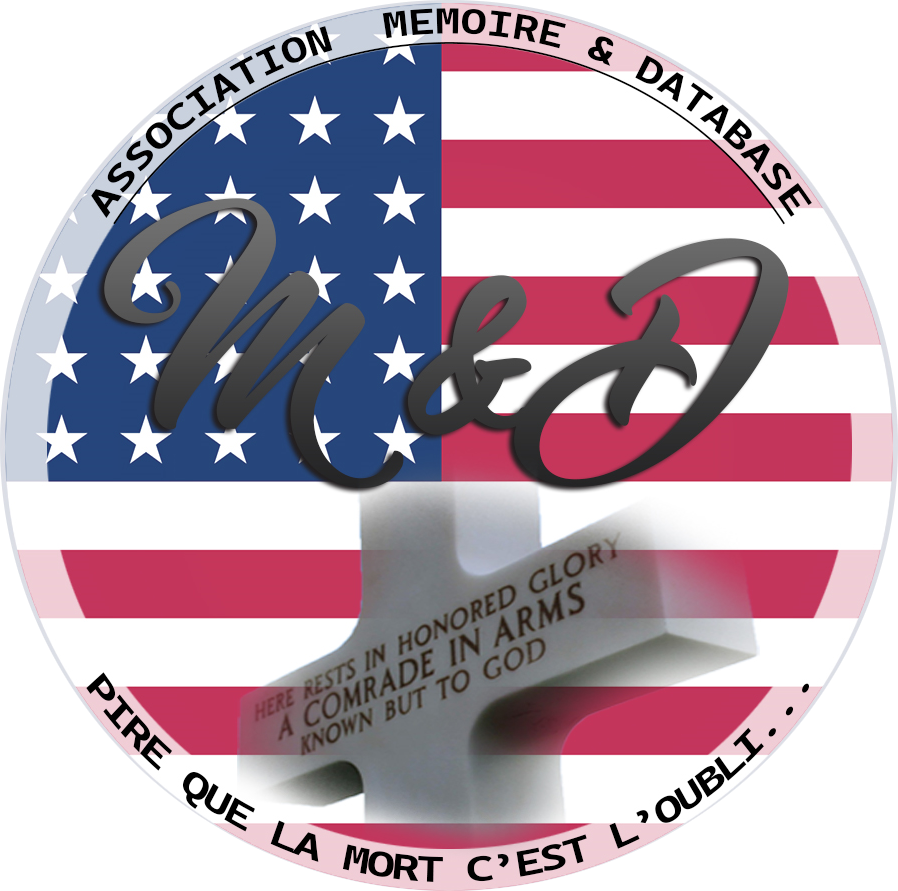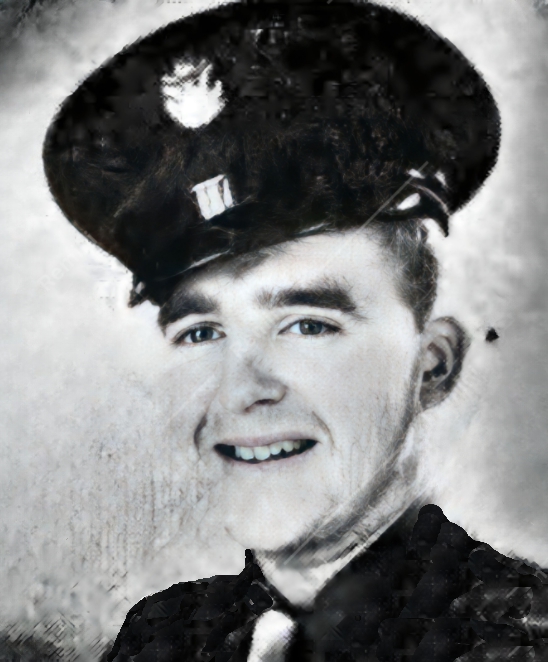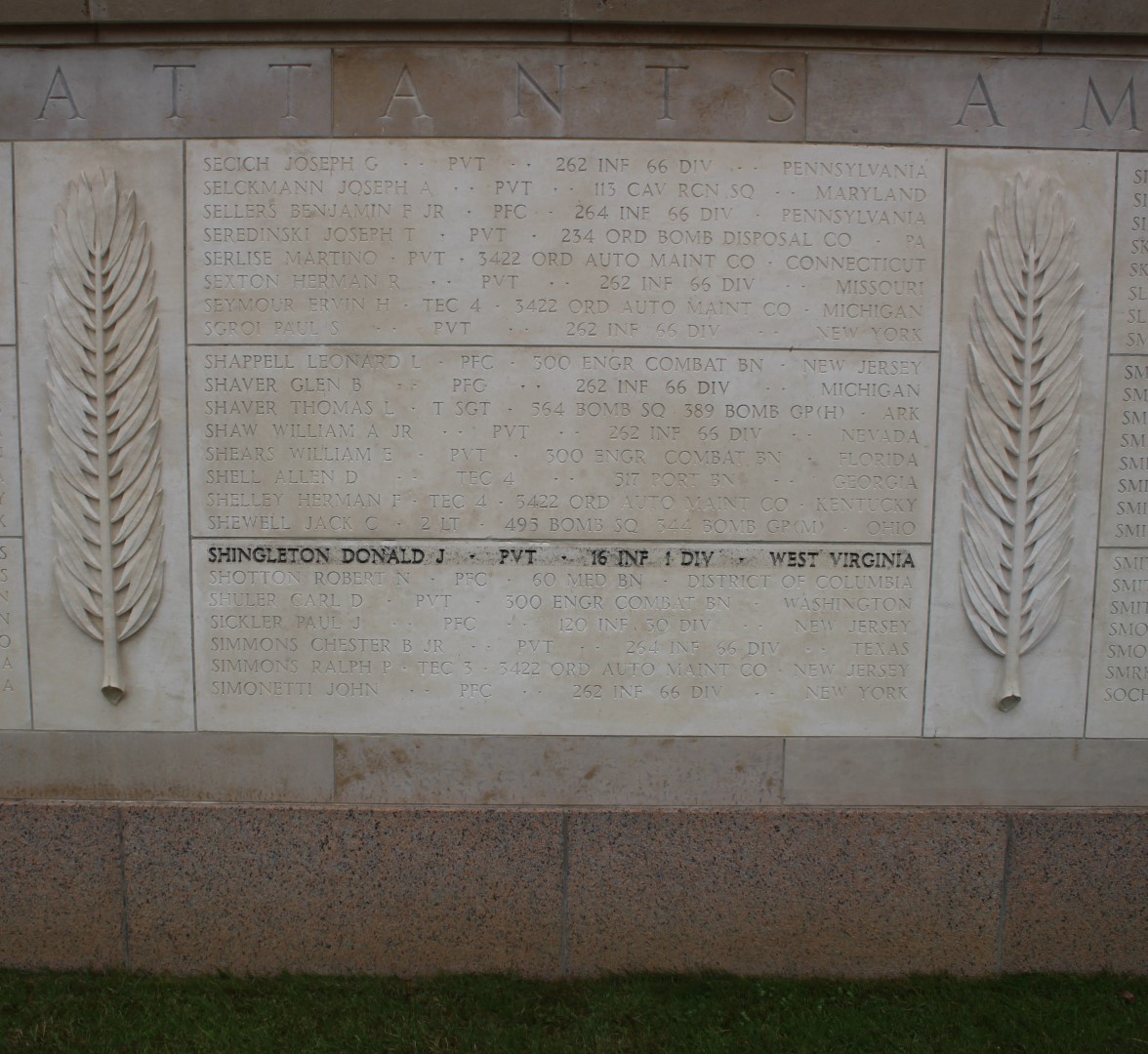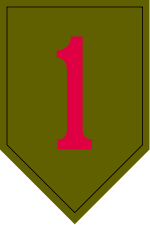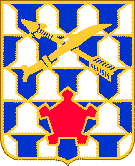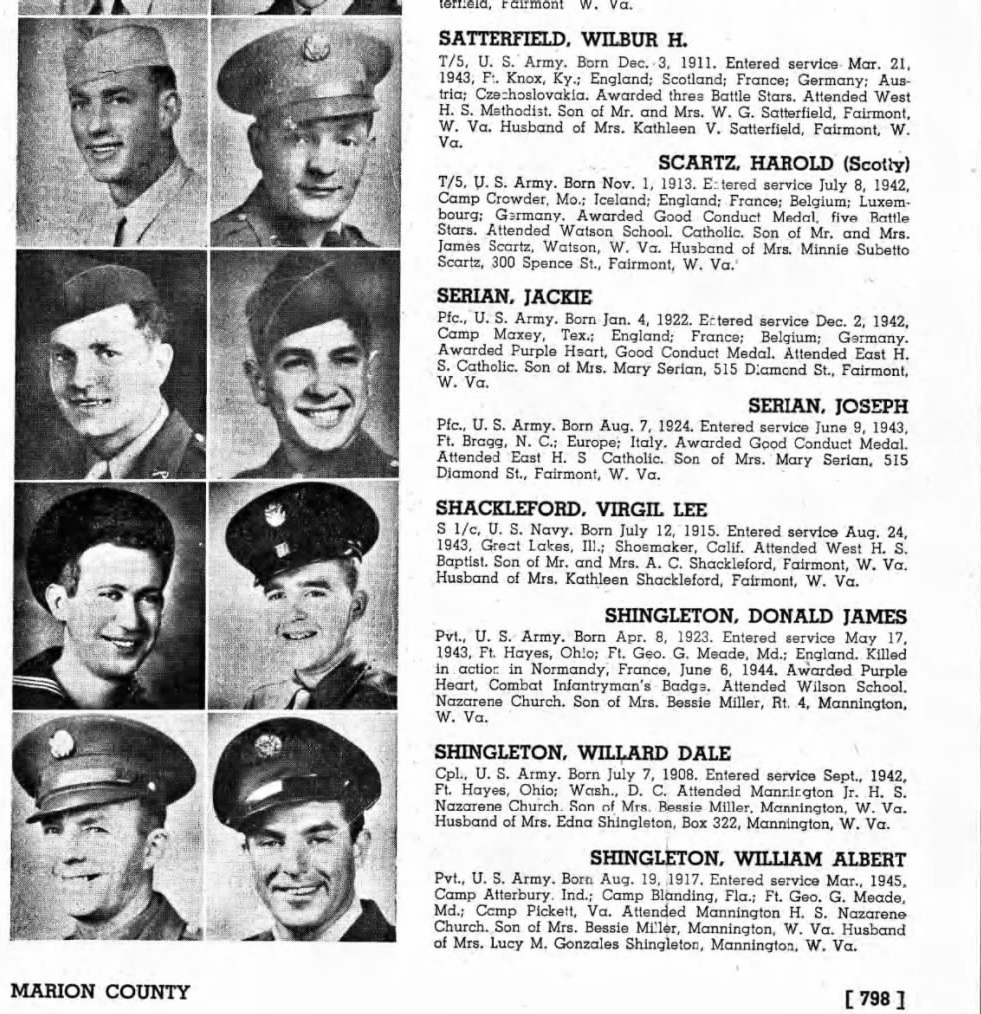|
Donald James SHINGLETON
| ||||||||||||||||||||||||||||
|---|---|---|---|---|---|---|---|---|---|---|---|---|---|---|---|---|---|---|---|---|---|---|---|---|---|---|---|---|
|
Source : Frogman (Ellen Marchese)
| ||||||||||||||||||||||||||||
| NUMBER OF SERVICE | 35754377 | |||||||||||||||||||||||||||
| AGE | 20 yo | |||||||||||||||||||||||||||
| DATE OF BIRTH | 8 February 1924 Mannington, Marion County, WEST VIRGINIA | |||||||||||||||||||||||||||
| ENLISTMENT STATE | WEST VIRGINIA | |||||||||||||||||||||||||||
| FAMILY | Single | |||||||||||||||||||||||||||
| RANK | Private | |||||||||||||||||||||||||||
| FONCTION | Infantry Man | |||||||||||||||||||||||||||
| JOB BEFORE ENLISTEMENT |  | |||||||||||||||||||||||||||
| DATE of ENLISTEMENT | 12 May 1943 Clarksburg WEST VIRGINIA | |||||||||||||||||||||||||||
| COMPANY | Company | |||||||||||||||||||||||||||
| BATTALION | Battalion | |||||||||||||||||||||||||||
| REGIMENT | 16th Infantry Regiment | |||||||||||||||||||||||||||
| DIVISION | 1st Infantry Division | |||||||||||||||||||||||||||
| DATE OF DEATH | 7 June 1944 |
Source : F Lavernhe | ||||||||||||||||||||||||||
| STATUS |
MIA FOD - Finding of Death 7 juin1945 | |||||||||||||||||||||||||||
| PLACE OF DEATH | Omaha Beach | |||||||||||||||||||||||||||
| CEMETERY | NORMANDY AMERICAN CEMETERY of Colleville | |||||||||||||||||||||||||||
| GRAVE |
| |||||||||||||||||||||||||||
| DECORATION |
| |||||||||||||||||||||||||||
| ||||||||||||||||||||||||||||
| STORY | ||||||||||||||||||||||||||||
|
Pvt Donald James Shingleton (ASN 35754377) was born on February 8, 1924 in Mannington, Marion, West Virginia. His father, Albert Shingleton, and his mother, Bessie Brice Schrader, were both born and raised in West Virginia. His father worked a variety of jobs with his last one being in the oilfield. Donald was the eighth of his parent’s ten children. He had five older brothers, two older sisters, and two younger brothers. Donald was born and raised in Marion County, West Virginia. His father died in January 1938 when Donald was 13 years old. The following month, his older brother, Robert, was killed in an automobile accident. In November 1938 his mother remarried and moved with her new husband to Hancock County about 100 miles away. Donald lived with his older brothers in Marion County and he graduated from Wilson High School in 1942. He was working at the Weirton Steel mill in Weirton, West Virginia when he received his draft card in July 1942. In May 1943 he received his induction notice and on May 12, 1943 he enlisted in the Army in Clarksburg, West Virginia. Donald was one of the many people drafted in 1943 in preparation for the invasion of Europe. He was assigned to Company K of the 16th Infantry Regiment in the 1st Infantry Division. He did his basic and infantry mostly at Fort George G. Meade in Maryland. In October 1943, the 16th Infantry had completed its assignment in Sicily and were locating to England. Donald joined the rest of the 16th Regiment in November 1943. Together, they would carry out seven months of grueling training in preparation for the Allied invasion of Normandy. The plan for D-Day was that Company K (Donald’s unit) would be the reserve for Companies I and L of the 16th Regiment’s 3rd Battalion who were leading the first wave of attack on the Fox Green sector of Omaha Beach near Colleville-sur-Mer. The lead companies were scheduled to hit the beach at 06:31, followed 30 minutes later by Company K from the 16th Infantry Regiment (IR). The ambitious objectives for the 16th IR were to exit the beach, capture the villages of Saint-Laurent-sur-Mer and Colleville-sur-Mer, and head south to meet with British units from Gold Beach. On June 1, 1944 the 16th Infantry Regiment departed Dorchester for the port of Weymouth. Troops from the 3rd Battalion of the 16th IR boarded the HMS Empire Anvil and late in the afternoon on June 5, 1944 they left Weymouth with the rest of the invasion fleet. At 03:30 troops from Company K started loading into their LCAs (Landing Craft Assault). As the K Company LCAs approached the beach at their designated time, they learned that Company L had just landed and that Company I had not landed, so Company K were ordered to take over I Company’s mission. The six LCAs of K Company had reached the beach safely, but as they were offloading, machine gun and sniper fire was sweeping the beach. Mortar and artillery fire had zeroed in on the “K” troops as they were departing the LCAs and inflicted 53 casualties before hitting the beach. Once on the beach, the commander of K Company was killed and the rest of the troops were pinned down and unable to move. The commander of the 16th IR, Col. George A. Taylor, landed at 08:15 and took charge by announcing, “Two kinds of people are staying on this beach, the dead and those who are going to die–now let’s get the hell out of here.” One of the Company K casualties that morning was Pvt. Donald James Shingleton, who was likely killed in action by one of the several direct hits from mortar fire. His body was never found and was initially declared MIA. Later, he was declared dead and his status was officially listed as FOD (Finding of Death). In 1956, the name of Pvt. Donald James Shingleton was one of the 1,557 service members whose names are on the Wall of the Missing at the Normandy American Cemetery and Memorial at Colleville-sur-Mer, Normandy, France. At the time of his death, he was survived by his mother and eight of his siblings. Four of his brothers also served in the Army during WWII. Le Pvt Donald James Shingleton (ASN 35754377) est né le 8 février 1924 à Mannington, Marion, Virginie-Occidentale. Son père, Albert Shingleton, et sa mère, Bessie Brice Schrader, sont tous deux nés et ont grandi en Virginie-Occidentale. Son père a occupé divers emplois, le dernier étant dans le champ pétrolifère. Donald était le huitième des dix enfants de ses parents. Il avait cinq frères aînés, deux sœurs aînées et deux frères plus jeunes. Donald est né et a grandi dans le comté de Marion, en Virginie-Occidentale. Son père est décédé en janvier 1938 alors que Donald avait 13 ans. Le mois suivant, son frère aîné, Robert, est tué dans un accident de voiture. En novembre 1938, sa mère s'est remariée et a déménagé avec son nouveau mari dans le comté de Hancock à environ 100 miles de là. Donald vivait avec ses frères aînés dans le comté de Marion et il est diplômé de la Wilson High School en 1942. Il travaillait à l'usine Weirton Steel à Weirton, en Virginie-Occidentale, lorsqu'il reçut sa carte de repêchage en juillet 1942. En mai 1943, il reçut son avis d'intronisation. et le 12 mai 1943, il s'est enrôlé dans l'armée à Clarksburg, en Virginie-Occidentale. Donald était l'une des nombreuses personnes enrôlées en 1943 en préparation de l'invasion de l'Europe. Il est affecté à la compagnie K du 16e régiment d'infanterie de la 1re division d'infanterie. Il a fait sa base et son infanterie principalement à Fort George G. Meade dans le Maryland. En octobre 1943, le 16th Infantry avait terminé sa mission en Sicile et se déplaçait en Angleterre. Donald rejoignit le reste du 16e Régiment en novembre 1943. Ensemble, ils effectueraient sept mois d'entraînement exténuant en vue de l'invasion alliée de la Normandie. Le plan pour le jour J était que la compagnie K (unité de Donald) serait la réserve des compagnies I et L du 3e bataillon du 16e régiment qui menaient la première vague d'attaque sur le secteur Fox Green d'Omaha Beach près de Colleville-sur- Mer. Les compagnies de tête devaient atteindre la plage à 06h31, suivies 30 minutes plus tard par la compagnie K du 16th Infantry Regiment (IR). Les objectifs ambitieux du 16e RI étaient de sortir de la plage, de capturer les villages de Saint-Laurent-sur-Mer et de Colleville-sur-Mer, et de se diriger vers le sud pour rencontrer les unités britanniques de Gold Beach. Le 1er juin 1944, le 16th Infantry Regiment quitte Dorchester pour le port de Weymouth. Les troupes du 3e bataillon du 16e RI montèrent à bord du HMS Empire Anvil et tard dans l'après-midi du 5 juin 1944, ils quittèrent Weymouth avec le reste de la flotte d'invasion. À 03h30, les troupes de la compagnie K ont commencé à charger dans leurs LCA (Landing Craft Assault). Alors que les LCA de la compagnie K s'approchaient de la plage à l'heure prévue, ils ont appris que la compagnie L venait d'atterrir et que la compagnie I n'avait pas atterri, alors la compagnie K a reçu l'ordre de reprendre la mission de la compagnie I. Les six LCA de la compagnie K avaient atteint la plage en toute sécurité, mais alors qu'ils déchargeaient, des tirs de mitrailleuses et de tireurs d'élite balayaient la plage. Les tirs de mortier et d'artillerie s'étaient concentrés sur les troupes "K" alors qu'elles quittaient les LCA et avaient infligé 53 victimes avant de toucher la plage. Une fois sur la plage, le commandant de la compagnie K a été tué et le reste des troupes a été bloqué et incapable de bouger. Le commandant du 16e RI, le colonel George A. Taylor, a atterri à 08h15 et a pris les commandes en annonçant : "Deux types de personnes séjournent sur cette plage, les morts et ceux qui vont mourir. enfer d'ici. L'une des victimes de la compagnie K ce matin-là était Pvt. Donald James Shingleton, qui a probablement été tué au combat par l'un des nombreux coups directs de mortier. Son corps n'a jamais été retrouvé et a été initialement déclaré MIA. Plus tard, il a été déclaré mort et son statut a été officiellement répertorié comme FOD (Finding of Death). En 1956, le nom de Pvt. Donald James Shingleton était l'un des 1 557 militaires dont les noms figurent sur le mur des disparus au cimetière et mémorial américain de Normandie à Colleville-sur-Mer, Normandie, France. Au moment de sa mort, il laisse dans le deuil sa mère et huit de ses frères et sœurs. Quatre de ses frères ont également servi dans l'armée pendant la Seconde Guerre mondiale. | ||||||||||||||||||||||||||||
|
Source : Fold 3 | ||||||||||||||||||||||||||||
Activated/Activé |
Normandy/Normandie |
| 17 Jun 1917 | Days of Combat/Jour de Combat 443 |
| Casualties/Victimes 20 659 | |
Entered Combat/Entré au combat |
|
| 8 Nov 1942 North Africa | |
|
Commanding Generals/Commandants généraux Maj. Gen. Donald Cubbison (Feb 41 - Aug 42) |
Campaigns/CampagnesAlgeria-French Morocco (8 Nov 42 - 11 Nov 42)
|
PLAN DE ROUTE DE LA CAMPAGNE de MEDITERANNEE - CAMPAIGN ROUTE MAP |
|
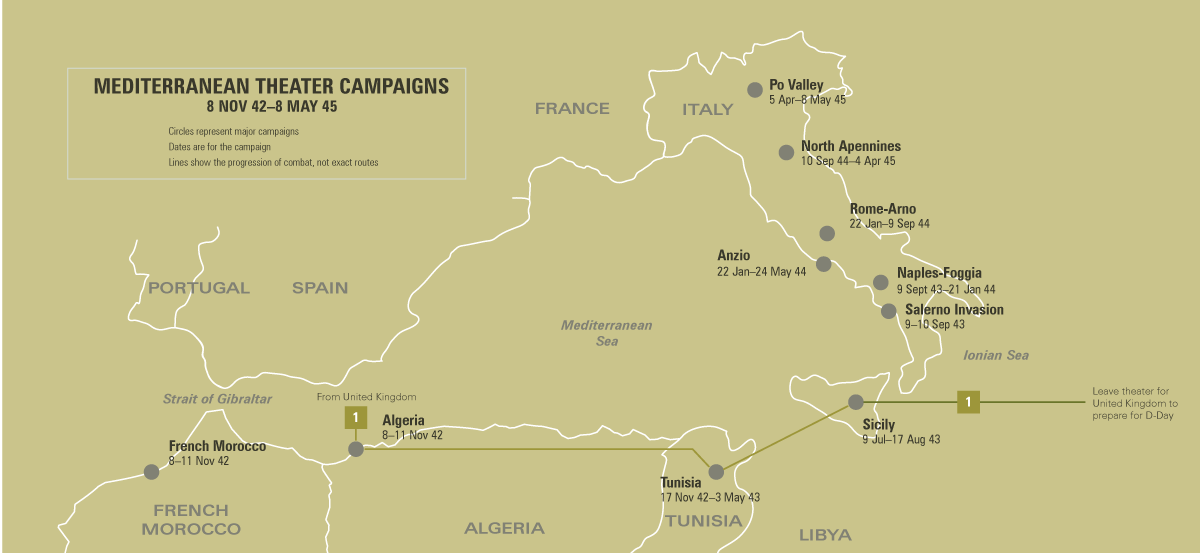 |
|
PLAN DE ROUTE DE LA CAMPAGNE - CAMPAIGN ROUTE MAP |
|
 |
|
DIVISION CHRONICLEThe 1st Infantry Division saw its first combat in World War II in North Africa, landing at Oran and taking part in the initial fighting, 8-10 November 1942. Elements then took part in seesaw combat at Maktar, Medjez el Bab, Kasserine Pass, Gafsa, El Guettar, Beja, and Mateur, 21 January-9 May 1943, helping secure Tunisia. The First was the first ashore in the invasion of Sicily, 10 July 1943 ; it fought a series of short, fierce battles on the island's tortuous terrain. When that campaign was over, the Division returned to England to prepare for the Normandy invasion. The First Division assaulted Omaha Beach on D-day, 6 June 1944, some units suffering 30 percent casualties in the first hour, and secured Formigny and Caumont in the beachhead. The Division followed up the St. Lo break-through with an attack on Marigny, 27 July 1944, and then drove across France in a continuous offensive, reaching the German border at Aachen in September. The Division laid siege to Aachen, taking the city after a direct assault, 21 October 1944. The First then attacked east of Aachen through Hurtgen Forest, driving to the Roer, and moved to a rest area 7 December for its first real rest in 6 months' combat, when the von Rundstedt offensive suddenly broke loose, 16 December. The Division raced to the Ardennes, and fighting continuously from 17 December 1944 to 28 January 1945, helped blunt and turn back the German offensive. Thereupon, the Division attacked and again breached the Siegfried Line, fought across the Roer, 23 February 1945, and drove on to the Rhine, crossing at the Remagen bridgehead, 15-16 March 1945. The Division broke out of the bridgehead, took part in the encirclement of the Ruhr Pocket, captured Paderborn, pushed through the Harz Mountains, and was in Czechoslovakia, at Kinsperk, Sangerberg, and Mnichov, when the war in Europe ended.
|
CHRONIQUE DE DIVISIONLa 1ère Division d'infanterie vit son premier combat en Afrique du Nord lors de la Seconde Guerre mondiale, débarquant à Oran et prenant part aux combats initiaux, du 8 au 10 novembre 1942. Les éléments participèrent ensuite aux combats en balançant à Maktar, Medjez el Bab, Col de Kasserine, Gafsa, El Guettar, Beja et Mateur, du 21 janvier au 9 mai 1943, contribuant à la sécurisation de la Tunisie. Le premier a été le premier à terre dans l'invasion de la Sicile, le 10 juillet 1943; il a combattu une série de batailles courtes et féroces sur le terrain tortueux de l'île. Quand cette campagne fut terminée, la Division revint en Angleterre pour se préparer à l'invasion de la Normandie. La première division a attaqué Omaha Beach le jour J, le 6 juin 1944, certaines unités subissant 30% de pertes au cours de la première heure et sécurisant Formigny et Caumont dans la tête de pont. La Division a suivi la percée de Saint-Lô avec une attaque sur Marigny, le 27 juillet 1944, puis a traversé la France dans une offensive continue, atteignant la frontière allemande à Aix-la-Chapelle en septembre. La Division a assiégé Aix-la-Chapelle après un assaut direct, le 21 octobre 1944. Le Premier a ensuite attaqué à l'est d'Aix-la-Chapelle par Hurtgen Forest, jusqu'à la Roer, et s'est installé dans une aire de repos le 7 décembre pour son premier repos. combat de mois, quand l'offensive de von Rundstedt se déchaîna subitement, le 16 décembre. La division a couru vers les Ardennes, et combat continuellement du 17 décembre 1944 au 28 janvier 1945, a aidé à émousser et à retourner l'offensive allemande. La Division attaqua de nouveau la ligne Siegfried, traversa la Roer, le 23 février 1945, et se dirigea vers le Rhin, traversant la tête de pont de Remagen, du 15 au 16 mars 1945. La division sortit de la tête de pont. dans l'encerclement de la poche de la Ruhr, capturé Paderborn, poussé à travers les montagnes du Harz, et était en Tchécoslovaquie, à Kinsperk, Sangerberg et Mnichov, lorsque la guerre en Europe a pris fin.
|
| SOURCE INFORMATION & PHOTO | Armydivs.squarespace.com |
|---|
| SOURCE INFORMATION & SOURCE PHOTO | Fold3.com - Aad.archives.gov - Abmc.gov - Findagrave.com |
|---|---|
| PROGRAMMER | Henri, Garrett, Clive, Frédéric & Renaud |


